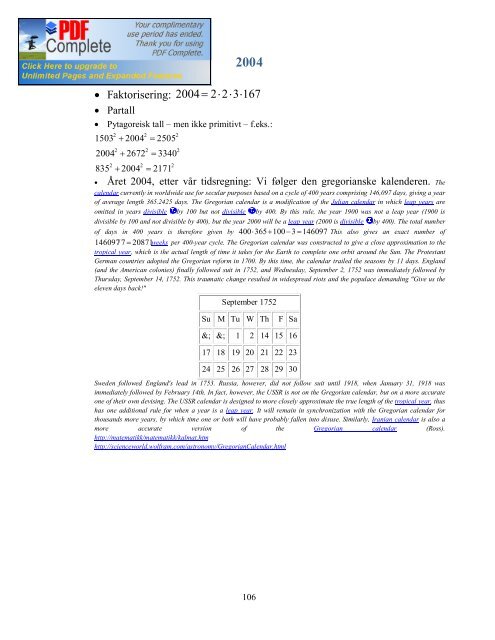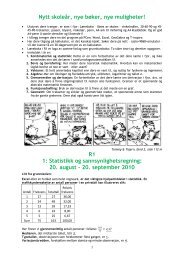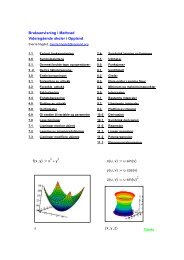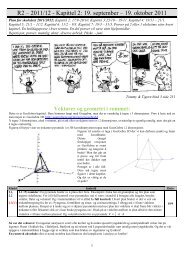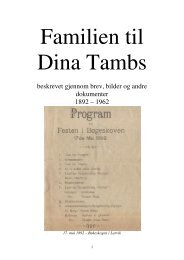Tall-leksikon - Matematikk på nett - Nordreisa videregående skole
Tall-leksikon - Matematikk på nett - Nordreisa videregående skole
Tall-leksikon - Matematikk på nett - Nordreisa videregående skole
You also want an ePaper? Increase the reach of your titles
YUMPU automatically turns print PDFs into web optimized ePapers that Google loves.
Dagens tall:<br />
2004<br />
• Faktorisering: 2004 = 2⋅<br />
2⋅<br />
3⋅167<br />
• Partall<br />
• Pytagoreisk tall – men ikke primitivt – f.eks.:<br />
2<br />
2<br />
2<br />
1503 + 2004 = 2505<br />
2<br />
2<br />
2<br />
2004 + 2672 = 3340<br />
2<br />
2<br />
2<br />
835 + 2004 = 2171<br />
• Året 2004, etter vår tidsregning: Vi følger den gregorianske kalenderen. The<br />
calendar currently in worldwide use for secular purposes based on a cycle of 400 years comprising 146,097 days, giving a year<br />
of average length 365.2425 days. The Gregorian calendar is a modification of the Julian calendar in which leap years are<br />
omitted in years divisible by 100 but not divisible by 400. By this rule, the year 1900 was not a leap year (1900 is<br />
divisible by 100 and not divisible by 400), but the year 2000 will be a leap year (2000 is divisible by 400). The total number<br />
of days in 400 years is therefore given by 400 ⋅365+ 100 − 3 = 146097 This also gives an exact number of<br />
146097 / 7 = 20871weeks<br />
per 400-year cycle. The Gregorian calendar was constructed to give a close approximation to the<br />
tropical year, which is the actual length of time it takes for the Earth to complete one orbit around the Sun. The Protestant<br />
German countries adopted the Gregorian reform in 1700. By this time, the calendar trailed the seasons by 11 days. England<br />
(and the American colonies) finally followed suit in 1752, and Wednesday, September 2, 1752 was immediately followed by<br />
Thursday, September 14, 1752. This traumatic change resulted in widespread riots and the populace demanding "Give us the<br />
eleven days back!"<br />
September 1752<br />
Su M Tu W Th F Sa<br />
&; &; 1 2 14 15 16<br />
17 18 19 20 21 22 23<br />
24 25 26 27 28 29 30<br />
Sweden followed England's lead in 1753. Russia, however, did not follow suit until 1918, when January 31, 1918 was<br />
immediately followed by February 14th. In fact, however, the USSR is not on the Gregorian calendar, but on a more accurate<br />
one of their own devising. The USSR calendar is designed to more closely approximate the true length of the tropical year, thus<br />
has one additional rule for when a year is a leap year. It will remain in synchronization with the Gregorian calendar for<br />
thousands more years, by which time one or both will have probably fallen into disuse. Similarly, Iranian calendar is also a<br />
more accurate version of the Gregorian calendar (Ross).<br />
http://matematikk/matematikk/kalmat.htm<br />
http://scienceworld.wolfram.com/astronomy/GregorianCalendar.html<br />
106


